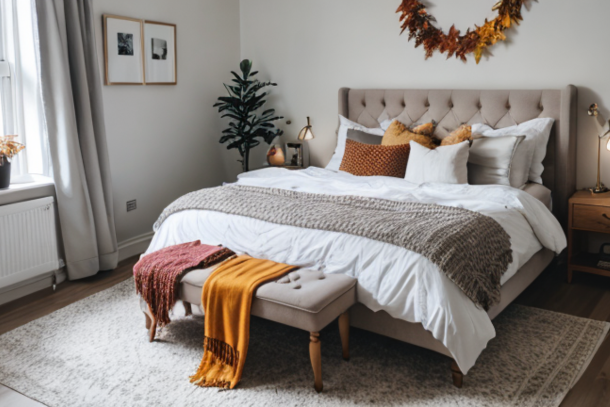Unlock the Power of Naps: 10 Surprising Facts about Daytime Napping

Daytime napping, a universal yet intriguing phenomenon, is the subject of this enlightening piece. For centuries, humans have been practising the art of the midday snooze, both as a respite from daytime toil and as a form of relaxation. These brief intervals of shut-eye, taken apart from the traditional night's sleep, are what we collectively refer to as 'daytime naps.'
The Relevance of Daytime Napping
In our fast-paced society, the art of napping is sometimes neglected or, worse, considered a sign of laziness. However, mounting scientific evidence points to the contrary. It suggests that a short, intentional rest during the day can have profound benefits on various aspects of human health and productivity.
The Power of Naps
Napping, far from being an unproductive indulgence, can actually be an incredibly powerful tool. From boosting cognitive function and creative thinking to improving mood and even physical health, the positive implications of a quick daytime nap can be astonishing.
Addressing Myths and Misconceptions
Yet, the practice is often misunderstood. Common misconceptions can discourage people from incorporating this beneficial habit into their daily routines. This article aims to dispel those myths and shed light on the true power of daytime napping.
Discover the Daytime Napping Benefits
So, if you're a sceptic, curious, or already a nap aficionado looking to maximise your snooze, read on. You are about to explore the science-backed benefits of daytime napping, delve into the history of this practice, and unearth ten surprising facts about the power of naps. Prepare to be amazed as you journey into the fascinating world of daytime napping benefits.
The History of Daytime Napping
Daytime napping isn't just a modern practice influenced by hectic lifestyles but rather has deep historical and cultural roots.
Ancient Civilisations and Daytime Napping
In ancient times, cultures around the world valued and practised daytime napping. The Romans, for instance, cherished their 'sixth-hour' nap, a tradition reflected in their architecture, with villas featuring dedicated spaces for midday rest.
Meanwhile, Ancient Egyptians saw napping as a spiritual practice, often depicted in hieroglyphs as the pharaohs resting during the day to gain favour from the gods. This part of the history of napping suggests its multifaceted value: beyond physical rest, it was a part of spiritual growth and societal routines.
Cultures Practising Siestas
The siesta is perhaps the most famous nap-time tradition. Originating from Spain, the term 'siesta' is derived from the Latin 'hora sexta', meaning 'the sixth hour'. It was designed to provide an escape from the afternoon heat and also allowed for a restorative break in the middle of the day.
Today, siestas are a staple in Spanish culture and have spread to various parts of the world, particularly in hotter climates, such as Latin America, the Mediterranean, and the Philippines.
Modern-Day Napping Practices
In our modern world, while some societies have moved away from the tradition of daytime napping in favour of continuous work schedules, the custom remains deeply ingrained in others. Countries like Japan have embraced 'inemuri' or 'sleeping while present', allowing workers to nap at work.
Clearly, the history of napping shows us that this practice, far from being a sign of laziness, is a time-honoured tradition appreciated for its physical and psychological benefits.
Understanding Sleep Stages
The Four Stages of Sleep
Sleep is a complex process that is split into multiple stages, each with its own distinct physiological and neurological characteristics. The four main stages of sleep are:
Stage 1: Light Sleep
In this stage, you drift in and out of sleep and can be easily awakened. Your eye movements and muscle activity slow down.
Stage 2: Deeper Sleep
Your eye movements stop, and your brain waves become slower. This stage accounts for the majority of your total sleep.
Stage 3: Deep Sleep
This is the restorative stage of sleep, where the body repairs muscles and tissues, stimulates growth and development and boosts immune function.
REM Sleep: Rapid Eye Movement Sleep
This is the stage of sleep where most dreaming occurs. Your eyes move rapidly, heart rate and blood pressure increase, and brain activity levels are similar to when you're awake.
Naps and Sleep Stages
The stage during which naps fall can vary depending on their length. Short "power naps" of around 20 minutes usually don't go beyond the lighter stages of sleep, helping to increase alertness and concentration without leaving you feeling groggy. Longer naps, of around 60 to 90 minutes, can include deeper sleep stages and REM sleep, which can contribute to improved creativity and problem-solving skills. However, they may also result in "sleep inertia," a period of grogginess and disorientation upon waking.
Understanding these sleep stages can help us optimise our napping habits to get the most out of them and enhance our overall health and productivity.
The Optimal Duration of a Nap
Understanding the optimal length of a nap is essential to reap the most benefits. It's a delicate balance — nap too little, and you might not feel refreshed; nap too long, and you could wake up groggy and potentially disrupt your night-time sleep.
Studies on Nap Length
Various studies have sought to understand the perfect nap duration. A study from NASA on sleepy military pilots and astronauts found that a 40-minute nap improved performance by 34% and alertness by 100%.
The same study also suggested that 20-minute naps were ideal for boosting alertness and motor skills. This duration usually limits you to the lighter stages of non-rapid eye movement (NREM) sleep, making it easier to get back into the swing of things post-nap.
On the other hand, longer naps of around 90 minutes are typically enough time to cycle through all the stages of sleep, including REM sleep. This is where you can experience dreams and improve creativity, and emotional and procedural memory.
The Ideal Duration
Despite these findings, the "ideal" nap length can be a bit subjective and depends on individual needs.
For a quick pick-me-up, the "power nap" of about 10-20 minutes can be just the ticket. It can provide a swift boost to energy and alertness without leaving you feeling groggy or interfering with nighttime sleep.
For cognitive improvement, a 60-minute nap may be more beneficial, as this length typically includes slow-wave sleep, known to aid with memory consolidation.
A full cycle nap of 90 minutes helps with creativity and emotional and procedural memory, reducing the risk of waking up groggy.
The key is to understand your personal sleep needs and adjust your napping habits accordingly to achieve the optimal nap length.
Napping Can Boost Creativity
Scientific Findings on Napping and Creativity
A wealth of scientific evidence underlines the potential of napping to enhance creativity. According to a study from the University of California, Berkeley, napping can help with the cognitive process responsible for creative problem-solving. The researchers discovered that REM (Rapid Eye Movement) sleep, which can occur during a well-timed nap, stimulates regions of the brain associated with creativity. This enhanced brain activity facilitates the connection of unrelated ideas, fuelling creative thinking.
The Role of REM Sleep in Creativity
Notably, the key to this creative boost seems to lie in REM sleep, a stage where we often experience vivid dreams. REM sleep allows our brains to form associative networks, enabling us to come up with innovative solutions to complex problems. So, if you're searching for a burst of creativity, a nap could be just what you need.
Notable Figures Who Nap for Creativity
Napping isn't just for the tired or lazy; many illustrious figures have recognised the value of a good nap in their creative process. Renowned artists like Salvador Dali would often take 'micro-naps' to boost their creative energy. Inventor Thomas Edison, despite his famous quote about genius needing more perspiration than sleep, was known to take regular naps as a source of rejuvenation and creativity.
Salvador Dali's 'Micro-Naps'
Dali's unusual 'micro-nap' technique involved holding a key above a metal plate while he napped in a chair. As he drifted into deeper stages of sleep, he would drop the key, the noise waking him up. This technique allowed him to stay in the creative, hypnagogic state that exists just before deep sleep.
By understanding the napping and creativity link, we can better harness the power of daytime napping to fuel our innovative and imaginative capacities.
Daytime Napping Can Improve Learning and Memory
The Science Behind Napping and Memory
Research has consistently pointed to the beneficial effects of napping on memory and learning. According to a study conducted by the Harvard Medical School, participants who took a 60-minute nap after learning a new task showed significant improvement in their ability to recall the task as compared to those who didn't nap.
Another research from the University of California, Berkeley, discovered that napping for an hour in the afternoon can significantly boost brain power, leading to a higher learning capacity.
The Role of Sleep Cycles
During a typical nap, the brain goes through various stages of the sleep cycle. Of these stages, rapid eye movement (REM) sleep is of particular interest to researchers. During REM sleep, which often happens in the later part of a nap, our brain consolidates and processes the information we've learnt during the day, enhancing our memory.
Different Types of Memory
Interestingly, napping affects different types of memory in varying ways. Explicit memories, such as facts or events, are more likely to benefit from a longer nap that includes REM sleep. Implicit memories, on the other hand, like motor skills, can benefit from short naps, even those without REM sleep.
The practice of daytime napping, therefore, holds immense potential for boosting learning capabilities and enhancing memory function. It could be particularly beneficial to students, professionals, and anyone looking to improve their cognitive performance. As we continue to discover the benefits and power of napping, it's clear that these brief periods of rest are far from a waste of time; they are a powerful tool for memory optimisation.
Napping Can Reduce Stress and Improve Mood
Psychological Effects of Napping
Daytime napping, while physically restorative, also carries significant psychological benefits. This short period of rest can act as a peaceful retreat from the hustle and bustle of daily life, providing a much-needed mental break that helps reduce stress. Napping can foster a sense of relaxation and rejuvenation, lowering anxiety levels and enhancing one's overall well-being.
The Role of Napping in Stress Relief
Emerging research indicates that napping can physiologically reduce stress by decreasing cortisol levels, the body's primary stress hormone. A regulated level of cortisol is linked to improved mood, mental clarity, and even a boost in productivity, enhancing one's capacity to handle the challenges of everyday life more efficiently.
Correlation Between Napping and Mood
Daytime napping's effect on mood is another area of considerable interest. Studies have shown that regular naps can lead to improvements in mood, fostering feelings of happiness and reducing feelings of fatigue or irritability. A well-timed nap can essentially act as a 'reset' button for the brain, helping to lighten one's mood and promote emotional balance.
Scientific Findings on Napping and Mood
A study by the University of Michigan, for instance, found that a nap as short as an hour can make people less impulsive and more tolerant to frustration, indicating a direct link between napping and mood regulation.
In conclusion, daytime napping serves as a potent tool for stress relief and mood improvement. Incorporating this restful practice into your routine can significantly enhance mental health and overall quality of life.
The Power Nap's Impact on Physical Health
A good daytime nap is more than just a way to combat sleepiness. It plays an influential role in our physical health, particularly in relation to heart health and our immune system.
The Relationship between Napping and Heart Health
In our fast-paced world, heart disease is a significant health concern. Interestingly, napping can be a simple yet effective strategy for promoting heart health.
Regular Naps and Lower Heart Disease Risk
Recent studies suggest a correlation between regular naps and a lower risk of heart disease. In a study published in Heart, a journal of the British Cardiovascular Society, those who napped once or twice a week had a lower risk of heart disease and stroke compared to those who didn't nap at all. The exact reason is yet to be definitively established, but researchers believe that napping can reduce stress, a significant contributor to heart disease.
The Impact of Napping on Immune Function
Just as sleep is crucial to our immune function, napping plays its part too.
Napping: A Boost for the Immune System
Napping has been shown to contribute positively to immune health. In a study published in the Journal of Clinical Endocrinology & Metabolism, scientists found that a brief nap could reverse the negative health effects of a poor night's sleep, including the impact on interleukin-6, a protein with various functions in the immune system.
In conclusion, napping, when done properly, can offer significant benefits to your physical health. It's a simple, cost-free, and enjoyable way to boost heart health and immune function, truly underlining the power of naps.
Napping Isn't For Everyone
While napping can offer a host of benefits, it's important to note that it may not be suitable for everyone. Certain factors, such as individual health conditions, sleep patterns, and lifestyle choices, can influence whether daytime naps are beneficial or disruptive.
When Napping Might Not Be Beneficial
Firstly, it's worth mentioning that those with insomnia or other sleep disorders may find that napping exacerbates their conditions. This is because the extra sleep obtained during the day could make it harder to fall asleep at night, leading to a vicious cycle of sleep disruption.
Similarly, individuals who experience sleep inertia – the feeling of grogginess and disorientation that can come after waking up – may want to reconsider daytime naps. This feeling can reduce productivity and mood, negating the potential benefits of napping.
Impact on Nighttime Sleep
Daytime napping, particularly if done late in the day or for long periods, can interfere with your nighttime sleep schedule. The body's internal clock, known as the circadian rhythm, can be thrown off balance, causing difficulties in falling asleep or staying asleep at night.
Research shows that long or frequent naps can lead to poor nighttime sleep quality, potentially causing sleep deprivation and its associated health risks.
The Disadvantages of Napping
While napping can certainly be advantageous in many respects, it's crucial to understand the potential downsides. Poorly timed or overly long naps can lead to sleep inertia, circadian rhythm disruption, and nighttime sleep disturbances.
For those who struggle with sleep disorders or who find themselves feeling groggy after a nap, it might be worth reconsidering the habit or seeking advice from a healthcare professional to make sure you're napping healthily and effectively.
Best Practices for Effective Daytime Napping
In the realm of sleep science, the practice of daytime napping has been studied extensively. It's not just about closing your eyes for a few minutes; there's an art to it. Here are some napping tips to ensure that you make the most out of your siesta.
Create the Ideal Napping Environment
Comfort is Key
Find a quiet, dimly lit room where you can lie down. You could use an eye mask or earplugs to block out light and noise. Use a light blanket as your body temperature drops during sleep, even short ones like naps.
Timely Napping
A nap too late in the day can disrupt your night-time sleep. Aim to nap in the mid-afternoon, typically around 2 to 3 pm, when most people naturally experience a dip in energy levels.
How to Nap Effectively
Nap Duration
The ideal nap duration is around 20-30 minutes; any longer and you risk going into a deep sleep and waking up feeling groggy. This brief nap time provides a good balance of rest and rejuvenation without causing sleep inertia or affecting your night-time sleep.
Napping Routine
Try to establish a regular napping schedule. Just like your body becomes accustomed to waking and sleeping at certain times, it can also learn to nap at a certain time. A consistent routine can make it easier for you to fall asleep and wake up from your naps.
Post-Nap Wake Up
Aim for a gradual wake-up process to reduce the chances of feeling groggy. You could use a soft alarm tone or even a light-based alarm that simulates a sunrise to gently rouse you from your slumber.
Daytime napping, when done right, can be a powerful tool for boosting mental and physical health. Incorporating these napping tips into your routine can help you maximise the power of your naps.
The Power of Naps: Key Takeaways
From understanding our sleep stages and the rich history of daytime napping, we've journeyed through fascinating facts that underline the surprising power of naps. We discovered that an optimally timed nap can do wonders for our cognitive functions, creativity, and mood. Scientific studies have revealed a remarkable link between napping and boosted creativity, enhanced memory, and effective learning.
Moreover, beyond psychological well-being, napping also has significant physical benefits. Regular short naps have been associated with better heart health and improved immune function, indicating that the power of naps extends to holistic well-being. However, it's crucial to remember that the art of napping is not a one-size-fits-all, and for some individuals or circumstances, it might not be the best option.
Reiterating the Benefits
Understanding and harnessing the power of naps can be a game-changer for many, especially in our increasingly busy lives. Daytime naps can serve as a natural energy booster, a creativity enhancer, and a tool for stress relief. They provide a natural, restorative break that can refresh both our bodies and minds, helping us to be more productive, more creative, and healthier.
As we navigate our modern, fast-paced life, appreciating the power of naps can help us improve our routines and our health. So, whether you're a seasoned siesta taker or a curious newcomer, consider incorporating mindful napping into your life and experience the multitude of benefits it can offer.
Related to this article are the following:
I do hope you have enjoyed this article and hope that you will subscribe to my newsletter so you can get the latest information about all things naturally relaxing.
Stay in touch, join the Naturally Relaxing Newsletter
Newsletter Signup
Post Your Comments
or post as a guest
Be the first to comment.
Latest articles in Sleep

The Power of Waterfall Sounds for Enhanced Sleep Quality

Embracing Autumn: Sleep Routines for the British Season

Autumnal Slumber: Understanding Our Seasonal Sleep Patterns

Crafting the Ideal Autumnal Sleep Sanctuary

Savouring Autumn: Foods to Enhance Your Sleep






